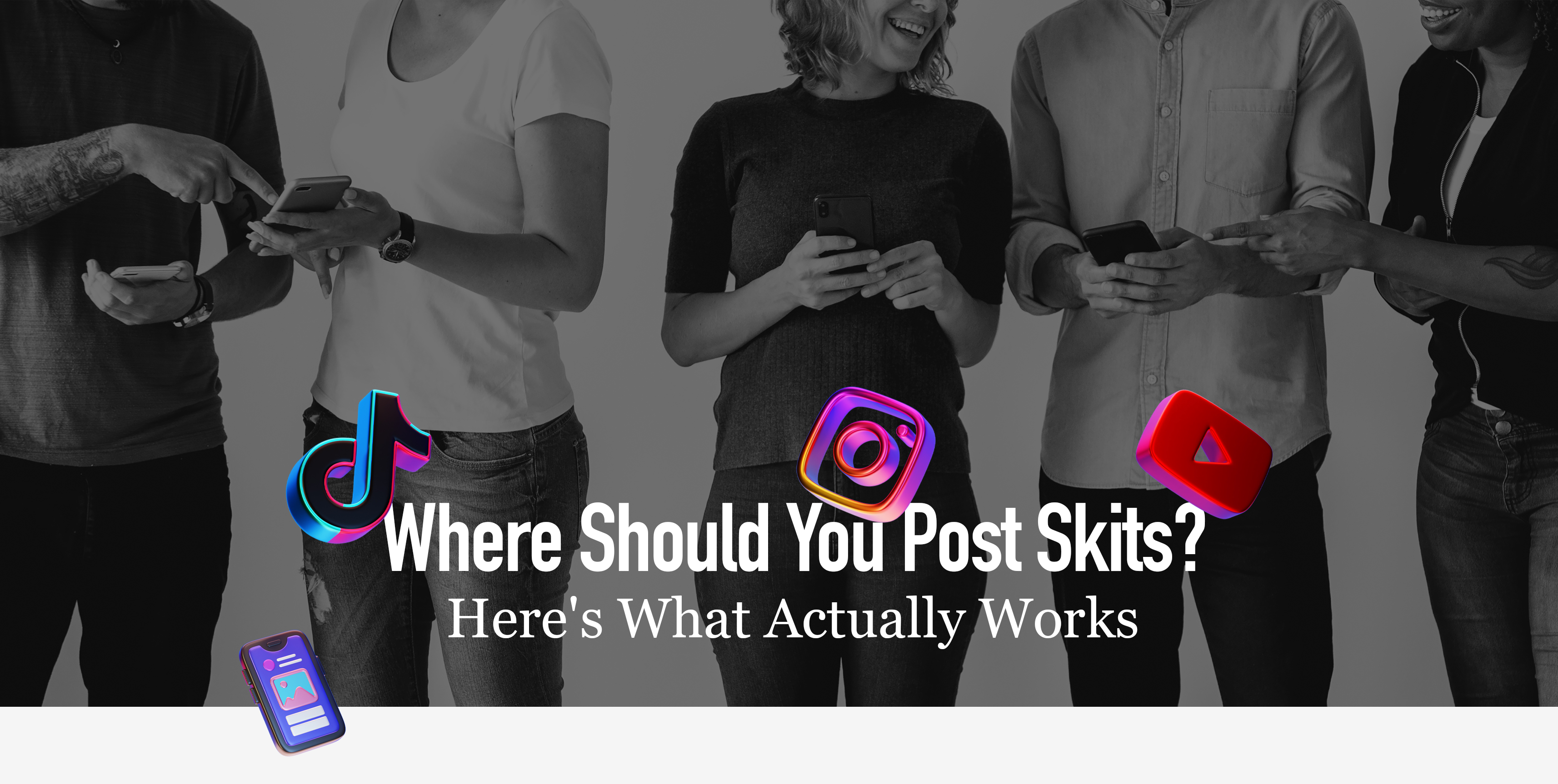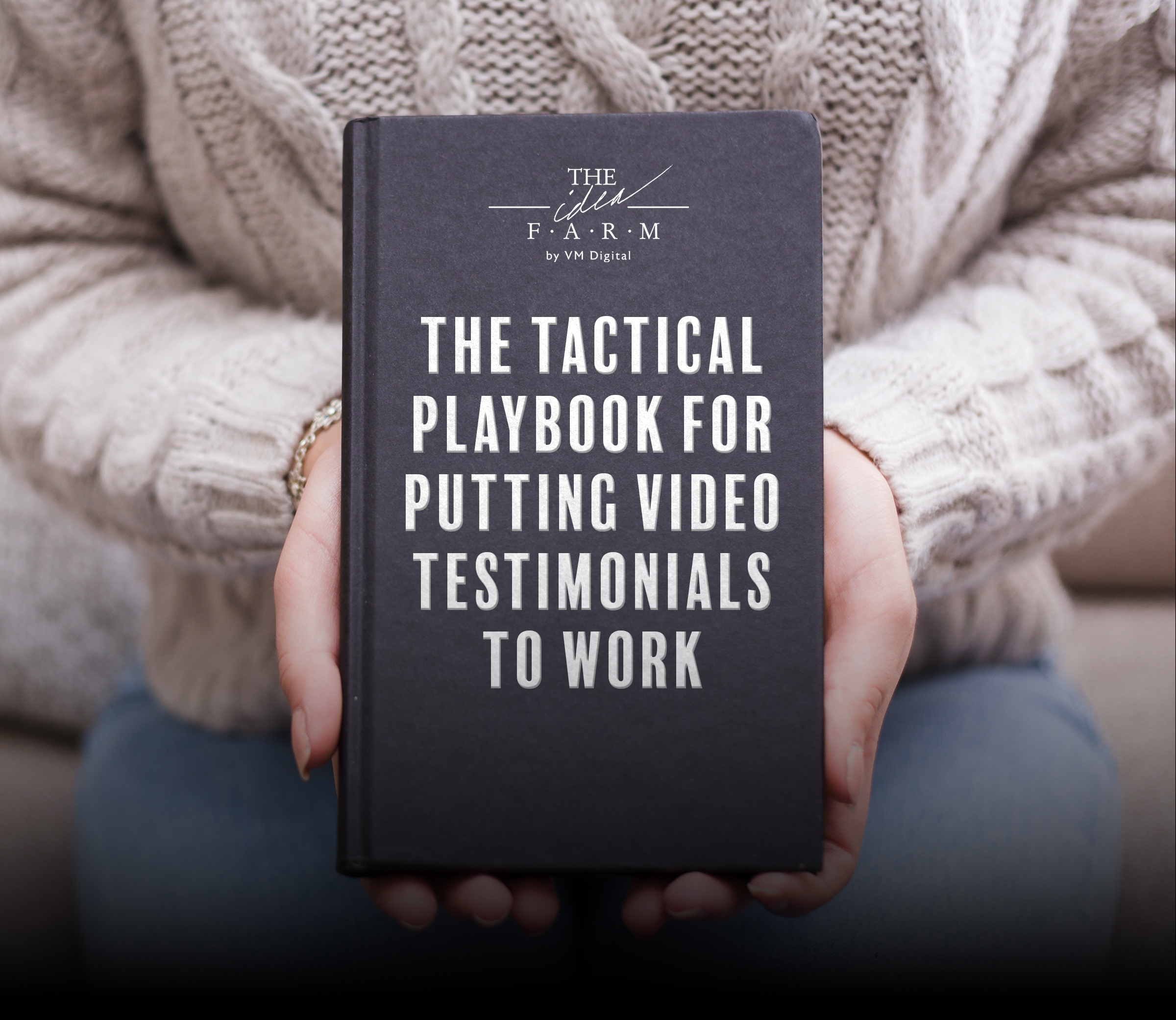In Part 1, we showed why short-form skits are no longer just for creators with ring lights and ring-worthy punchlines.
Brands like Duolingo, Mohawk Chevrolet, and The Chit Show proved that character-led, story-driven skits can do more than entertain, they can build real audience loyalty and transform social media channels into episodic entertainment platforms.
Now in Part 2, we’re diving into the strategy.
- Where should skits live?
- Why do they actually work so well?
- And how do you make something people want to return for, again and again
Let's start with the “where.”
WHERE: Best Places to Post Skits
TikTok: Where Episodic Content Thrives
TikTok is hands-down the best platform for recurring, character-driven storytelling. It’s engineered to surface bingeable content to new users, making it perfect for skits that evolve over time.
What makes TikTok ideal for skits:
- The algorithm favors multi-part stories and episodic structure.
- Viewers expect unpolished, authentic humor.
- Recurring characters and running gags do exceptionally well.
- Built-in features like playlists and pinned posts help organize your series.
You’re not just posting a video into the void, you’re giving the algorithm patterns to work with. Skit-style content delivers higher completion rates than non-episodic formats. And viewers are are more likely to follow a creator after watching two or more videos in a single session.
That’s a recipe for organic growth. One strong episode can pull viewers into a binge loop, and with every replay, your odds of landing on the For You page rise.
If you're planning a character-led series, or building humor around themes like customer mishaps, office culture, or product pain points, TikTok gives you both the stage and the spotlight.
Instagram Reels: Strong for Community and Visual Storytelling
Instagram may not push your skits to strangers as aggressively as TikTok, but it’s still one of the best places to build deeper connections with your existing audience.
Why Reels work well for skits:
- Instagram users already know your brand, skits reinforce connection.
- Strong performance for lifestyle, fashion, or visual-first humor.
- Pairs well with Stories, polls, and behind-the-scenes content.
There are limitations. Instagram doesn’t offer official playlists or a series feature, which means each skit needs to stand on its own. Running jokes and characters still work, but they need to be immediately recognizable, there’s no guarantee new followers will see past episodes.
That said, Meta reports that over 50% of time on Instagram is now spent watching Reels. The format is clearly sticky, especially when paired with:
- Teasers and follow-ups via Stories.
- Consistent skit formats with strong visual identity.
- Reels Highlights to organize your best episodes.
Instagram is especially valuable if your goal is to stay top-of-mind with an audience that already knows you. If TikTok is where people meet your brand, Reels is where they remember it.
YouTube Shorts: Quietly Powerful for Long-Form Brands
YouTube Shorts is often overlooked in the skit world, but it shouldn’t be. It combines short-form reach with the long-form infrastructure of a channel people can explore.
Best for:
- Brands that already produce long-form YouTube content.
- Creators using skits to tease or extend broader stories.
- Series that could scale into full-length formats later.
The numbers speak for themselves: YouTube Shorts now sees 70 billion daily views globally. And unlike TikTok, Shorts content continues to surface in search and suggested videos weeks after it’s posted.
Here’s how smart brands are using it:
- Launch a skit series in Shorts, then compile episodes into longer “supercuts.”
- Tease an upcoming product story or campaign.
- Drive traffic to full YouTube content using character-driven snippets.
Shorts may not have the cultural heat of TikTok, but for discoverability, long-tail growth, and connection to full-length storytelling, it’s a strategic channel with real staying power.
Main Account vs. Spin-Off: Where Should Skits Live?
One of the most common questions brands ask: should we post skits on our main account, or start fresh?
For most brands, post skits on your main account. Here’s why:
- It humanizes your feed and adds personality.
- You’re already talking to people who care about your voice.
- Starting a second account means rebuilding trust and reach from zero.
Brands like Mohawk Chevrolet are a perfect example. They launched The Dealership skit series directly on their core TikTok, and the payoff was massive. What began as a local marketing play turned into a national success story, driving thousands of new followers, community love, and even recognition from Chevrolet corporate.
And it’s not just anecdotal. According to SocialPeople, brands that post serial content on their main feed experience:
- Up to 42% more engagement across all content.
- Stronger retention and higher return viewership.
- More consistent visibility from platform algorithms over time.
When to consider a spin-off account:
- Your brand tone is formal or tightly regulated (e.g., medical, legal).
- You want to test a drastically different voice or creative direction.
- You're targeting a separate audience altogether.
Still, most audiences appreciate seeing a different side of a brand, as long as it’s consistent and intentional.
Quick Platform Fit Summary

WHY: Why Skits Work So Well
Skits might look like throwaway comedy on the surface, but behind the laughs is a surprisingly powerful engagement engine. The brands doing it well aren’t just trying to be funny, they’re building familiarity, emotion, and algorithmic leverage that traditional content can’t match.
Here’s what makes skits so effective (and why you keep seeing them in your feed):
1. Skits Are Emotionally Engaging
People don’t follow logos, they follow personalities. Skits tap into that by putting humans (or very human mascots) at the center of the story.
- A consistent character, even a fictional one, builds familiarity.
- Characters generate empathy, humor, even frustration, all of which drive engagement.
- Recurring roles give audiences something to root for, laugh at, or tag their friends in.
Whether it's Duo the Owl threatening to cancel your weekend or a dealership receptionist staging an Office-style protest over breakroom snacks, the emotional pull keeps viewers watching longer and coming back more often.
2. Skits Are Easy to Remember (and Quote)
In a crowded feed, recognition is currency. A good skit builds a world your audience remembers, even after the scroll.
- Catchphrases, character quirks, and running jokes act as mental shortcuts.
- Viewers don’t just “like” these videos, they quote them, remix them, and tag friends with inside jokes.
- Brand recall improves dramatically when people feel part of the bit.
It’s the same reason we still remember “Where’s the beef?” decades later. Only now, the catchphrase is “Do it, lady,” and it’s coming from a TikTok sketch filmed in a single afternoon.
3. They Reverse the Ad Formula
Traditional marketing: product first, maybe a story later. Skits flip that: story first, sell later, if at all.
That matters, because attention spans are shorter and skepticism is higher. Skits lower defenses.
- Audiences come for the humor, not the pitch.
- Viewers don’t feel like they’re being sold to, even if they are.
- When done right, the product becomes a background character in a world people want to visit.
According to a 2024 report from Michael Kirton, episodic branded content outperforms one-off promotional posts by up to 60% in repeat engagement over a 30-day period.
4. They Feed the Algorithm (Literally)
Platforms reward content that keeps users on the app. Skits, especially ones that run in sequences, do just that.
- Episodic formats encourage binge behavior → higher total watch time.
- Returning viewers boost retention metrics and follower velocity.
- Watch-through and rewatch rates are significantly higher than static ads or “talking head” content.
And it snowballs. One episode hits → people go back to watch older episodes → they follow → they get served the next one. That’s the loop. And platforms love it.
5. They’re Inherently Shareable
Skits are built for conversation. They reflect life, just more exaggerated, absurd, or relatable.
- “This is literally us” energy leads to tagging and DMs.
- Comedy disarms people, making them more likely to comment or share.
- Social-first storytelling builds community, not just audience.
Especially in group chats, Slack channels, and TikTok stitches, skits act as digital inside jokes. That shareability drives distribution far beyond the original audience.
HOW: Making Skits That Stick
It’s one thing to post a funny video. It’s another to create a skit that feels like part of a larger world, one that people come back for, binge through, and tell their friends about.
Here’s how to make that happen, step by step.
1. Build a Character (or Cast)
You don’t need trained actors or elaborate backstories. You just need a personality, or better yet, a few.
The most effective skit series revolve around recurring characters that feel familiar after just a few episodes. Think:
- A mascot with a short temper (see: Duo the Owl).
- An over-it receptionist with Office-style delivery (see: Mohawk Chevrolet).
- A middle-aged man named Chit who speaks in catchphrases and runs the world’s most awkward office.
What matters is recognition. Your audience should know who’s on screen before the punchline lands.
Characters build trust. According to SocialPeople’s 2024 survey, 81% of recurring series viewers said they felt a stronger connection to the brand because they “liked the character.”
2. Pick a World (And Stay in It)
Skits don’t need to be high-concept, they just need boundaries.
A consistent setting or scenario gives you room to play while keeping your story grounded. It also makes planning easier. You’re not reinventing the wheel, you’re just adding a new episode.
Common skit “worlds” that work:
- The chaotic small business office.
- A day in the life of your team (exaggerated, of course).
- A fictional version of your customer service inbox.
- Behind-the-scenes product moments that spiral into drama.
This is your sandbox. As long as the tone and environment stay familiar, you can keep building.
3. Plan a Loose Story Arc
Skit series don’t need a full script, they need a spine.
Map out 3–5 episode ideas around a theme. That gives you room to test what hits while building toward something.
Examples of easy formats:
- “Things Customers Say”- each episode spotlights a different absurd interaction.
- “Office Chronicles Vol. 1–5”- recurring staff drama with running jokes.
- “A Day in the Life of Our Intern”- chaos disguised as onboarding.
Even if the episodes don’t directly connect, give your audience a reason to expect more of the same.
4. Keep Production Simple, But the Story Tight
The best skits are the clearest. You can film on your phone, but your pacing, characters, and beats should be sharp.
Don’t overthink gear. Focus on:
- Clear audio (use a mic or quiet location if possible).
- Good lighting (natural light > office fluorescents).
- Strong opening seconds, hook the viewer in the first 3–5 seconds.
- Tight edits and deliberate pacing (cut out the dead space).
Audiences don’t care if you’re shooting on an iPhone, as long as the timing hits.
5. Design for Repeatability
Your first video might go nowhere. That’s fine. What matters is that you’ve built a structure you can keep using.
Think of it like a content engine, not a campaign. Repetition isn’t boring here, it’s branding.
The goal: Make it easier to create the next skit every time.
Ready to Start Something People Actually Want to Watch?
Skits build memory, loyalty, and personality in a way that static content rarely can. They give your brand a voice, a face — a reason for people to stick around, and come back.
And unlike high-gloss campaigns, skits don’t need a big budget. They need:
- A character (or cast) your audience can get to know.
- A world to play in.
- A format you can build on week after week.
Whether you’re posting to TikTok, Reels, or YouTube Shorts, the brands that win with skits are building series with rhythm, with toneith intent.
Want to bring your brand’s voice to life through storytelling?
Book a strategy session with The Idea Farm and we’ll help you shape the characters, cadence, and content structure that actually connects.
- Still catching up? Read our last post on skits that drive loyalty.
And for fresh examples every week: Subscribe to our newsletter.
.png)




































.svg)





.svg)